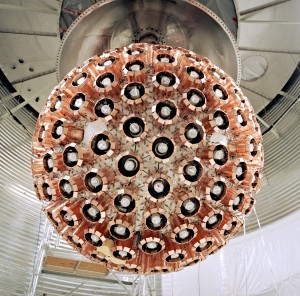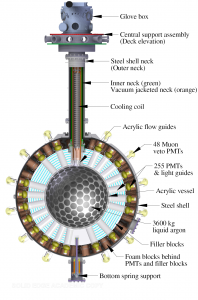The DEAP-3600 Experiment
Follow @deap3600
The origin of dark matter in our universe is one of the most important questions in particle astrophysics. One hypothesis which is currently favoured is that this dark matter is comprised of Weakly Interacting Massive Particles or WIMPs. Though not yet observed directly, the existence of dark matter can be inferred by its gravitational effects on stars and galaxies.
The DEAP Collaboration, a group of over 65 researchers from 18 institutions in Canada, the UK, Mexico, Germany, Spain, and Russia has developed the DEAP-3600 detector – one of the most sensitive experiments for the direct detection of dark matter.
DEAP has a competitive sensitivity to WIMP dark matter due to the design of the detector, where all components have been selected for extremely low levels of radioactivity, the very large target mass possible with liquid argon, and the very low background level achievable at the unique SNOLAB facility – a deep underground laboratory which uses the 2 km of rock overburden to filter out cosmic-ray muons and associated backgrounds that would otherwise interfere with WIMP detection.
The conceptual design of the central parts of the DEAP-3600 detector is shown on the left. The 2-inch thick ultraclean acrylic vessel (AV) with inner radius of 85 cm serves as the primary containment for the 3.6 tons of liquid argon. After fabrication of the vessel underground, the inner surface of the AV is “resurfaced” with a large sanding robot, to remove contamination from radon and radon daughters deposited on the acrylic during construction. The inner surface is then coated with tetraphenyl butadiene wavelength shifter to shift the ultraviolet (UV) light generated by argon scintillation to the visible region, which can then be transmitted to the 255 8″ diameter Hamamatsu R5912 high quantum efficiency (HQE) photomultiplier tubes (PMTs) through the acrylic, which detect the generated light. More …



